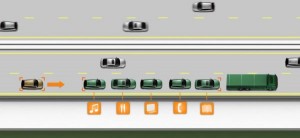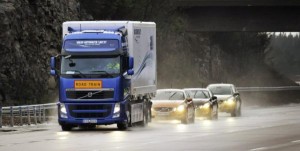 A vehicle platoon is a group of vehicles that travels in close proximity to one another, nose-to-tail, at highway speeds. A lead vehicle is followed by a number of other vehicles that closely match their speed and manoeuvres to the lead vehicle.
A vehicle platoon is a group of vehicles that travels in close proximity to one another, nose-to-tail, at highway speeds. A lead vehicle is followed by a number of other vehicles that closely match their speed and manoeuvres to the lead vehicle.
A vehicle platoon might be one of the technological benefits of self-driving (autonomous vehicles), but it doesn’t come without its problems. This article explores the advantages and disadvantages (some of which are quite significant).
Vehicle platoons have been proposed since at least the early 1960s. Various universities and government-funded organisations have worked on them since then. Before we had wireless communication, GPS and commercially available radar sensors, proposals often included some kind of mechanical coupling between the vehicles, quite like a ‘road train’ (although, not like a road train you’ll see barreling through the outback).
With the exponential power and reliability of autonomous cars, vehicle platooning could be a reality using a mix of technology that’s already available such as drive-by-wire steering and throttle control, radar cruise control, lane keep assist systems, GPS, Bluetooth, parking sensors, and cameras that can register and interpret 3D images such as Subaru’s EyeSight system. These features could allow cars to communicate with one another so that a lead car could control a number of following cars.
Advantages of vehicle platoons
- Because vehicles can travel more closely together at a steady speed, it increases the capacity of the road, meaning less roads have to be built long-term
- The lead vehicle will shoulder the same aerodynamic drag as regular driving, but all following vehicles will be drafting the vehicle in front and therefore experience reduced wind resistance. This leads to fuel savings
- Efficiencies in traffic speed and fuel economy should lead to lower freight costs
- When moving away from a stop, e.g. traffic has halted due to an obstruction or traffic light, a platoon will move away all at the same time. Humans wait until they see the vehicle in front move, then move away, and this delay compounds over a number of vehicles. Studies have shown that this form of moving away can be up to five times more efficient in terms of the number of cars moved through a specified point from rest.
- Initially all vehicles will have to have a driver ready to take control of the vehicle, but eventually fully automated vehicles will be able to take complete control and the driver becomes a passenger that is able to eat, work, watch a film, or sleep
- The accident rate may reduce because, in theory, vehicles in the platoon are aware of what each other is doing. However, these benefits are already coming to modern vehicles that brake for you if they perceive a threat that you don’t take action on (e.g. Volvo City Safety).
Disadvantages of vehicle platoons
Unfortunately the disadvantages of vehicle platoons far outweigh (in number) the advantages.
- Who would want to drive the lead vehicle? People would want to be in a following vehicle to derive the benefits of better fuel economy and drivers may deliberately move out of the lead position and slot back in at the back like some Olympic time trials cycle race.
- Some models have suggested a professional driver be the lead driver in a platoon. This will create a problem if the platoon is split as none of the other cars can adopt the lead position, and that means that platoons can’t be flexible with cars leaving and joining, and new platoons forming to travel to different destinations fluidly
- Vehicles following closely lose some of the cooling flow of air that would pass over the radiator, which could lead to overheating
- Mixed vehicles will have differing braking and acceleration characteristics, which risks nose-to-tail accidents.
- Vehicle platoons will not work at stop signs
- At traffic lights there is a risk that not all the cars will get through the junction, either in terms of time, or that there may not be enough space on the other side of the junction to accommodate all the vehicles.
- Platoons could be 25 vehicles in length, creating an obstruction that is over 120 metres long. If a vehicle not in the platoon wants to change lanes, for example to exit the highway, there would be no room to slot in between the vehicles in the platoon as they will be following closely together. The platoon vehicles will need to recognise when a vehicle is indicating to move into the lane, and break the platoon.
- As each vehicle in the platoon will need to communicate with the vehicle in front and the lead vehicle, this means a wireless connection will need to be established. As no computer system is completely hacker-proof, a vehicle platoon could be taken over by a third party. This will be of particular concern to freight companies if trucks are included, and you would certainly never find a truck carrying gold bullion as part of a vehicle platoon.
- Drivers will need to learn new skills and may have to have a special endorsement on their licence to travel in a platoon. This wouldn’t necessarily stop unapproved drivers from trying to enter a platoon, though.
- Some drivers may attempt to drive in a platoon without the right skills, or tag on the back of a platoon with a vehicle that is not capable of being in a platoon. Police would need a way of recognising this and dealing with it.
- Older cars might not be capable of having vehicle platoon technology easily retrofitted.
- New cars could come with platoon technology, but it’s likely to be more expensive and not every driver will get the benefit from it. It’s perhaps better in a commercial environment on long journeys, such as from Perth to Melbourne, however…
- …if there is a vehicle platoon on a single-lane road, it creates something that is impossible for pass not only for regular drivers but for emergency services, and therefore…
- …the last vehicle in the platoon would need to have awareness of an emergency vehicle approaching from behind, in which case the last vehicle would need to be able to communicate this to the lead vehicle
- While the accident rate might decrease, insurance companies might recognise new accident threats with a vehicle platoon, and therefore might disclaim against accidents caused or incurred by driving in one. For example, if all vehicles are travelling one metre apart and a truck turns in front of the lead vehicle, not giving it enough time to stop before crashing into it and abruptly stopping, all following vehicles will be involved in a nose-to-tail as there is no buffer that would be afforded by using the two-second rule.
- Not every vehicle’s final destination will be the same, therefore each vehicle needs to be able to communicate to every other vehicle in the platoon what its intentions are, and as it moves from the platoon, the other vehicles will close the gap. This means there will have to be a standard form of communication that each vehicle understands. Who will control and administer this standard, and will all vehicle manufacturers agree to follow it? Otherwise we could end up with a Betamax vs. VHS battle.
- As the government takes tax from fuel sales, improving fuel economy like this will mean tax will need to come from somewhere else. This could result in tax being unfairly applied through different means, or an overall increase in the tax on fuel to compensate.
Therefore vehicle platoons are only currently feasible on fairly free-flowing highways, and only travelling in the overtaking lane so that other vehicles aren’t blocked from moving over to exit the highway. They will work best if there are two or more vehicles leaving from the same destination and arriving at the same destination, too.
Australia does have enough of a dual carriageway highway network for vehicle platoons to give some benefit, but there wouldn’t be the benefit that you would see in Europe or America. There is still plenty of scope to improve fuel economy using engine technology and better vehicle aerodynamics.
Vehicle platoon progress
Volvo has demonstrated SARTRE (Safer Road Trains for the Environment) whereby a Volvo truck was followed by three Volvo cars on a highway situation at Volvo Proving Ground near Gothenburg, Sweden. This was as a result of a European Commission-funded project investigating whether vehicle platooning could be implemented on unmodified European motorways.
 The project was initiated in September 2009. It was demonstrated in January 2011 with one lead professional driver in a truck followed by an autonomous car that measured the distance, speed and direction of the vehicle in front. In January 2012 there was a second demonstration in Barcelona, Spain, with a truck and three cars. Any of the following vehicles could leave the platoon at any time. The platoon reached a speed of 90kph with gaps between the vehicles of no more than 6m.
The project was initiated in September 2009. It was demonstrated in January 2011 with one lead professional driver in a truck followed by an autonomous car that measured the distance, speed and direction of the vehicle in front. In January 2012 there was a second demonstration in Barcelona, Spain, with a truck and three cars. Any of the following vehicles could leave the platoon at any time. The platoon reached a speed of 90kph with gaps between the vehicles of no more than 6m.
Only Volvo participated in this demonstration.
Recently, (early January 2014), UK Department for Transport has commissioned research to understand how platooning technology might benefit UK businesses, the environment, the transport network and road safety. The feasibility study should result in a trial by the end of 2014.
